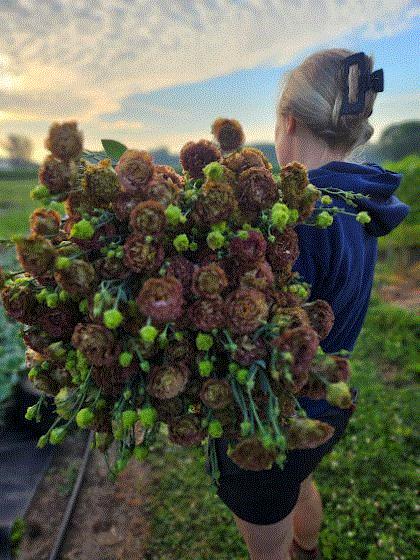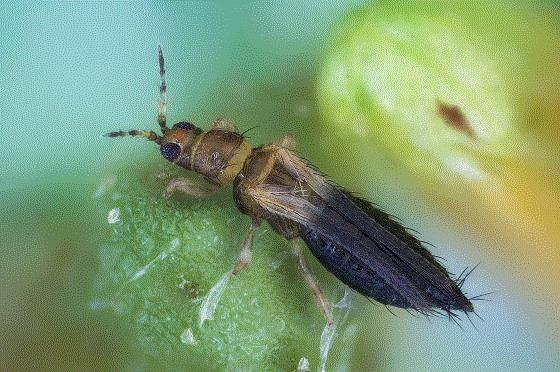December Farm Update

'Rosanne 'Terracotta' lisianthus are the perfect shade of chocolate mousse.
It’s hard to believe we are in the thick of the holiday season. Tater and I are thinking about you cut greens-growing folks who are covered in sap and holiday ribbons. I guess you can call me a Grinch, but I am glad we skip wreath and evergreen sales (although I love Christmas, just not sap). I can imagine it’s a magical experience, and hopefully a profitable one for your farm.
Tater and I use the month of December to outline our production plan for the following season. We are knee-deep in seed catalogs and on the hunt for sweet quality sweet pea seeds. For those of you who are looking for sweet peas, Ball Seed has early season varieties such as Spring Sunshine and Winter Sunshine. Spring Sunshine Peach is one of my favorite varieties of all time.
If you are looking for Spencer Sweet Peas, our friends at Express Seed/InFlora just started carrying a small but mighty assortment. I’m thrilled that some of our suppliers are finally jumping on the sweet pea train. In the past, buying sweet peas from boutique flower farms was like buying Taylor Swift tickets ... I'm still reeling from that experience!
I am in Grand Rapids, Michigan, this week for the Great Lakes Expo. My goal is to scope out some nifty implements to help our outdoor flower growing to be more efficient, and also to connect with some of my favorite industry friends.
Meanwhile, Tater and the Forget Me Not crew are digging chrysanthemums and flipping greenhouses around to get ready for Mother’s Day crops. That’s another thing that’s hard to believe: At the end of the month, we sow a boatload of anemone, ranunculus, stock and snapdragons for Mother’s Day. Greenhouses need compost and steaming before then.
In this edition of Bloom Beat I will share some highlights from the educational sessions at the show and some other musings. In the meantime, I would love to know how you feel about Pantone’s Color of the Year. Tater and I would love to hear your thoughts. Personally, I love Mocha Mousse! Feel free to ponder this while reading the rest of the newsletter. But don’t forget to drop us a line about it at ldaschner@ballpublishing.com.
With all that being said, let’s talk shop!

Take Advantage of Those Early Order Deadlines!

Like Tater, are you still reveling in the afterglow of last season? It’s time to get off your duff and get your plug orders in! Some suppliers offer early order discounts—some as high as 10%! Be sure to check in with your favorite brokers and ask for more details.
Tater and I will be finalizing our lisianthus order with the lovely folks at Raker-Roberta's Young Plants by the end of the week! They have a lot of breathtaking varieties and colors. Honestly, it's hard to finalize our list, because Tater and I fall in love with the prospect of a new variety every time we open the catalog. Oh, in case you were wondering, their early order deadline is December 15! It pays to be early, especially if you are ordering a sizeable amount of plug trays. Don’t wait—your pocketbook and your suppliers will thank you.
The Skinny on Pepper Thrips

Adult female pepper thrip. Photo from the University of Georgia.
At the Great Lakes Expo, I had the pleasure of listening to Dr. Erich Schoeller, assistant professor at the University of Georgia, talk about a new threat to flower and produce: Thrips parvispinus, aka the pepper thrip. Don’t let the "pepper" in the name fool you—this pest has the potential to become a major problem to flower crops across the country!
Originally from Thailand, these baddies are now a problem across the world, including but not limited to the Netherlands, Florida, Georgia, Colorado and even Michigan. This is a relatively new problem; pepper thrips were first detected in Florida in 2022. Researchers are still learning the nuances of this pest. Pepper thrips are apparently traveling across the country on shipments of foliage plants and tropicals.
When scouting for pepper thrips, be sure to check the underside of the leaves and leaves in the lower canopy. These thrips can also be on the tops of plants and in the flowers when infestations are severe. The key is to catch this problem before it gets to that point! The pepper thrip has a chocolate-brown head, light brown thorax and chocolate-colored abdomen. When looking at them under a microscope you will notice the segments on their antennae rotate as black and white segments, which is a stark contrast to other thrips. They are also smaller than other thrips; they are slightly larger than the diameter of a pencil lead. Pepper thrips are sexually dimorphic, meaning males and females look different. Females exhibit the dark coloration on the head and abdomen as mentioned above, but males are lighter in color and even smaller than the females. And where males are present you will also find females.
Pepper thrips have a wide host range. Tropical plants are the most common, such as gardenia, schefflera, hoya and mandevilla. Poinsettias are also a host. But pepper thrips, as the name implies, love peppers and other food crops, including citrus, eggplant and strawberries.
When scouting, look at your most susceptible crops first. As with western flower thrips you will see foliar damage, leaf curl/distortion and black spots on the foliage from frass (insect droppings). The challenge with pepper thrips is that the damage looks similar to broad mite damage, and if you are using chemical controls for mites, it's not going to work well on thrips. If you are new to scouting, check out this
VIDEO on scouting for thrips. It’s also prudent to talk to your favorite floriculture extension agent if you are having trouble identifying a pest.

More Pepper Thrips
How much a problem will pepper thrips be for you? It depends on how warm your winters are. In the Great Lakes region where Tater and I farm, it will likely just be a greenhouse pest. The folks in the Netherlands have been battling this insect for six years but only in greenhouses. Their winters are cold and the ground freezes, so the eggs do not survive from season to season. Most thrips are active once temperatures are above 45F. But growers in the southern US may have more troubles in the field with this pest. Pepper growers in the south are especially concerned since pepper thrips in Asia can quickly destroy 90% of a crop. For us northerners, if you are not starting clean in your high tunnels, there is a good chance that you have thrips populations overwintering in your soil. Be sure to consider this in your IPM plan for early season flowers.
The good news, according to the preliminary research, is that conventional chemicals for thrips are effective against pepper thrips. According to
Dr. Livia Ataide at the University of Florida, spinosads (products such as Conserve) work well to control them. Dipping your cuttings before sticking is also a great strategy that kills thrips populations before they enter your production facility. BotaniGard and SuffOil are great for this.
A little prevention goes a long way. Thrips larvae (not just pepper thrips) are spread through soil/plug mix. Preliminary research shows that biological controls are limited for this kind of thrips and it's not the most economical option in most operations. Orius work well; they are the “honey badger” of the biological world, but they need to be released weekly for pepper thrips control. You should start releasing Orius two weeks after dipping your cuttings. Dr. Schoeller states that
Ambylseius swirksii may be a viable predator but data backing this conjecture remains to be seen.
Growers have used sticky traps and large cards to trap pepper thrips. It’s a low-cost way to eliminate 15%-30% of thrips populations. Thrips are attracted to blue cards; however ,if you are using this method it may be useful to use yellow cards so you catch other critters, such as whitefly, as well.
Once again, it behooves us growers to connect with our extension educators and our suppliers to come up with cost-saving and effective strategies for new challenges like this one. In this case, an ounce of prevention seems to be better than a pound of cure.

New Ball Seed Cut Flower Catalog is out
While you are getting your plug orders together, it's also time to pour over your favorite seed catalogs. I was thrilled to get the 2025-2026 Ball Seed catalog in the mail two weeks ago. If you haven’t seen it yet, here is a link to the DIGITAL EDITION.

It is big and beautiful (82 pages is enough to keep you busy for a while)! I am excited to explore the new varieties of delphinium; it's one of my favorite flowers of all time. But there are other items ranging from dianthus, sunflowers, scabiosa and much more. The photos in the digital edition are linked to plant profiles, so you are just one click away from gaining a better understanding of the flower you are looking at. You will want to bookmark this and add it to your favorites on your web browser!
Ball Seed is going back to their roots. George J. Ball (pictured in his sweet pea greenhouse) founded Ball Seed in 1905 as a cut flower breeder and seed supplier. According to the website, George focused on breeding on his own strains of calendulas, sweet pea, and asters. His goal was to make them easier to grow and more disease-resistant, improving the production process for the cut flower industry as a whole. Almost 120 years later, Ball Seed, now in its fourth generation of Ball family, continues to provide high-quality cut flower seed, plugs, liners, bulbs and tissue culture. George would be proud!

Campanulove Campaign Promotes More Campanula!
 Karel Peterse of Sakata and the Campanulove campaign. Photo by Sakata Ornamentals EMEA
Karel Peterse of Sakata and the Campanulove campaign. Photo by Sakata Ornamentals EMEA
Deck the halls ... with campanula bells? The folks at Sakata, Royal FloraHolland (the big Dutch flower auction), Florensis, Kwekerij Stadsland and Evanthia are partnering to spread the
“Campanulove.” This was the first year for the marketing campaign, designed to shed light on the year-round possibility for campanula—they are not just a spring flower!
According to Karel Peterse, Product Manager for cut flowers at Sakata, “Although florists and consumers are quite familiar with campanula, it’s generally perceived as a spring flower. With Campanulove we try to show that its quality and versatility deserve a place in every season.”
For those of you unfamiliar with campanula, they are a darling spray of bell shape flowers—showstopping in arrangements! The folks at Royal FloraHolland and wholesaler Heemskerk gave florists
complimentary cases of campanula earlier this year. Florists were surveyed the week after this promotion, and they said campanula sales increased by 20% compared to the week prior.
According to Karel, their campanula showcase at Trade Fair Aalsmeer last month received positive reactions.
“We are growing demand for campanulas, and their prices increase. I think that the Campanulove has contributed to this development. This is only the first year for the campaign, and possibly repeating our message is as important as the message itself.”
Tater and I had the pleasure to get some plug trays of lit campanula trays in late winter and again in June of this year. Our florists enjoyed the extended season. I can see campanula having a staple place in our local market. It’s well worth considering. However, bear in mind that campanula is a long-day plant, and if you try to grow plugs when they days are already long, (with no daylength manipulation), you get short, squatty stems. Check out Sakata's
CULTURE SHEET for more information about daylength requirements for Campanula. You can also check out my previous
Bloom Beat on campanula.
Enthusiastically!
Lindsay Daschner (and Tater)
Editor-at-Large—Bloom Beat
Owner—Forget-Me-Not Farms
This email was received by 6,276 of your fellow fresh-cut flower growers!
If you're interested in advertising in Bloom Beat, contact Kim Brown and she will hook you up!